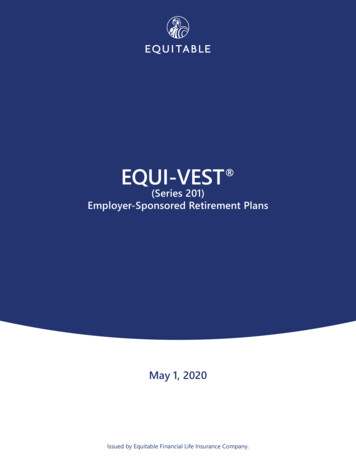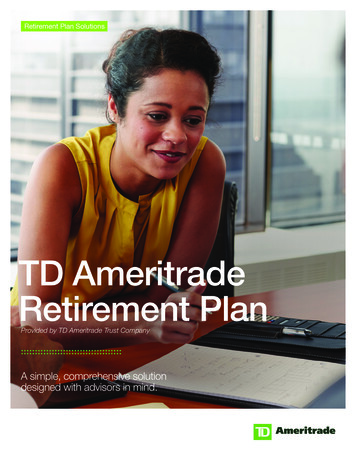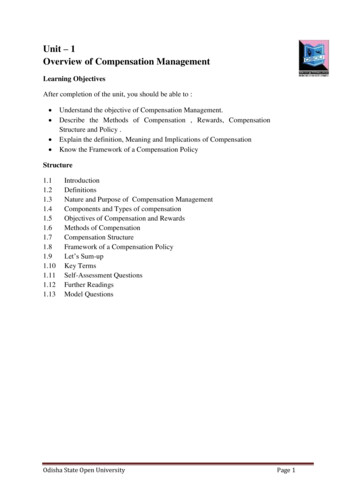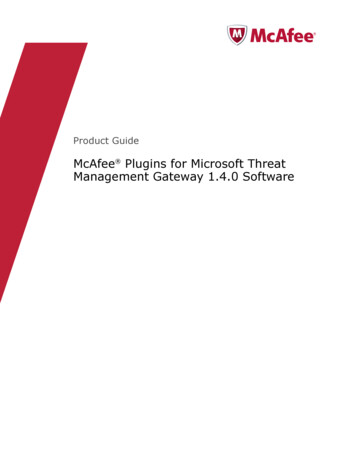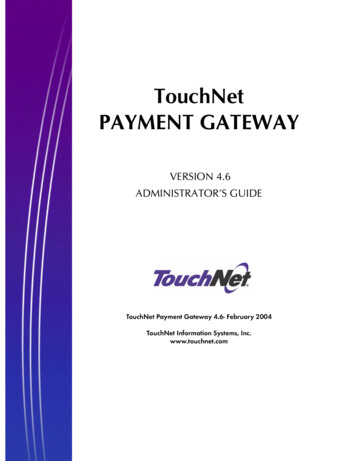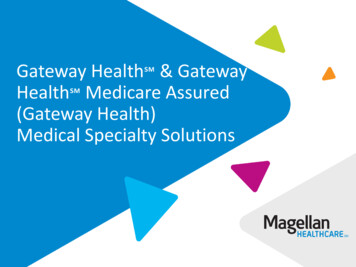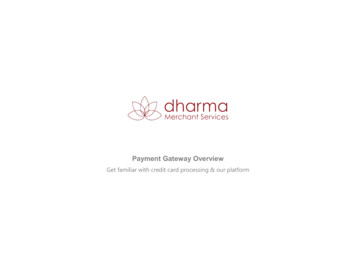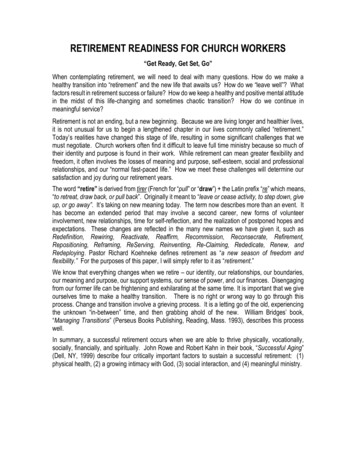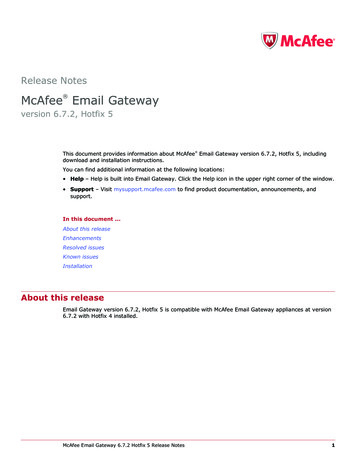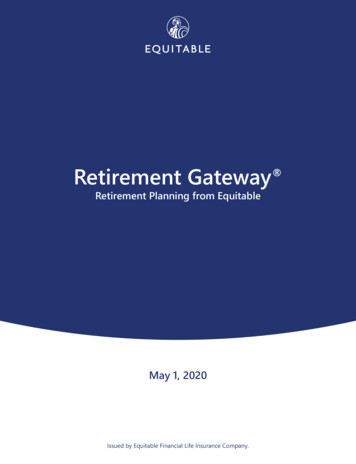
Transcription
Retirement Gateway Retirement Planning from EquitableMay 1, 2020Issued by Equitable Financial Life Insurance Company.
Table of ContentsSummary ProspectusesPage LabelEQ Premier VIP TrustEQ/Aggressive AllocationEQ/Conservative AllocationEQ/Core Plus BondEQ/Moderate AllocationEQ Advisors Trust1290 VT DoubleLine OpportunisticBond1290 VT Equity Income1290 VT GAMCO Mergers &Acquisitions1290 VT GAMCO Small CompanyValueEQ/AB Small Cap GrowthEQ/Balanced StrategyEQ/BlackRock Basic Value EquityEQ/Capital Group ResearchEQ/ClearBridge Large Cap GrowthEQ/ClearBridge Select EquityManaged VolatilityEQ/Common Stock IndexEQ/Conservative Growth StrategyEQ/Conservative StrategyEQ/Core Bond IndexEQ/Equity 500 IndexEQ/Franklin Small Cap ValueManaged VolatilityEQ/Franklin Strategic IncomeEQ/Franklin Templeton AllocationManaged VolatilityEQ/Global Bond PLUSEQ/Global Equity Managed VolatilityEQ/Goldman Sachs Mid Cap ValueEQ/Growth StrategyEQ/International Core ManagedVolatilityEQ/International Equity IndexEQ/International Value ManagedVolatilityEQ/Invesco ComstockEQ/Invesco GlobalEQ/Janus EnterpriseEQ/JPMorgan Value OpportunitiesEQ/Large Cap Core ManagedVolatilityEQ/Large Cap Growth IndexEQ/Large Cap Growth ManagedVolatility(883762)AAA 1-7ACA 1-7CMSB 1-10AMA 1-7VTDO 1-8VTEI 1-5VTGM 1-6VTGSC 1-4AASCG 1-5ABSA 1-7EQBBV 1-5EQCGR 1-5ACBLC 1-5AMLCEMV 1-8EQCTI 1-4ACGA 1-7ACSA 1-8EQCBI 1-5EQ500I 1-4AFSCVMV 1-8EQFSI 1-9EQFTAMV 1-9EQGBP 1-8AGEMV 1-9EQGSMCV 1-6AGSA 1-7AICMV 1-8EQIEI 1-5AIVMV 1-8EQICK 1-5EQOG 1-5AJE 1-6EQJPMV 1-4ALCCMV 1-8EQLCGI 1-4EQLCGMV 1-8Page LabelEQ/Large Cap Value ManagedVolatilityALCVMV 1-8EQ/Loomis Sayles GrowthALSG 1-5EQ/MFS International GrowthEQMG 1-6EQ/MFS International Intrinsic ValueEQMFIV 1-7EQ/MFS Technology IIEQIST 1-6EQ/Mid Cap IndexEQMCI 1-5EQ/Mid Cap Value Managed Volatility AMCVMV 1-8EQ/Moderate Growth StrategyAMGSA 1-7EQ/Money MarketEQMM 1-5EQ/PIMCO Real ReturnEQPRR 1-9EQ/PIMCO Total ReturnEQPTR 1-9EQ/PIMCO Ultra Short BondEQPUS 1-7EQ/Quality Bond PLUSEQQBP 1-8EQ/Small Company IndexEQSCI 1-4EQ/T. Rowe Price Health SciencesEQTRPHS 1-6EQ/Templeton Global EquityManaged VolatilityATGEMV 1-9Multimanager Core BondMMCB 1-9Multimanager Mid Cap GrowthMMMCG 1-6Multimanager Mid Cap ValueMMMCV 1-6
EQ PREMIER VIP TRUSTEQ/Aggressive Allocation Portfolio – Class A and B SharesSummary Prospectus dated May 1, 2020Before you invest, you may want to review the Portfolio’s Prospectus, which contains more information about the Portfolioand its risks. The Portfolio’s current Prospectus and Statement of Additional Information (“SAI”), dated May 1, 2020, as maybe amended or supplemented from time to time, and the Portfolio’s audited financial statements included in its annualreport to shareholders dated December 31, 2019, are incorporated by reference into this Summary Prospectus. You canfind the Portfolio’s Prospectus, SAI, reports to shareholders and other information about the Portfolio online atwww.equitable-funds.com/allportfolios.aspx. You can also get this information at no cost by calling 1-877-222-2144 or bysending an e-mail request to service@equitable.com. This Summary Prospectus is intended for use in connection with avariable contract as defined in Section 817(d) of the Internal Revenue Code (“Contracts”) and certain other eligible investorsand is not intended for use by other investors.Beginning on January 1, 2021, as permitted by regulations adopted by the Securities and Exchange Commission, you maynot be receiving paper copies of the Portfolio’s annual and semi-annual shareholder reports unless you specifically requestpaper copies from the insurance company that offers your Contract, from your financial intermediary, or from the Portfolio.Instead, the shareholder reports will be made available on a website, and you will be notified by mail each time ashareholder report is posted and provided with a website link to access the shareholder report.If you already elected to receive shareholder reports electronically, you will not be affected by this change and you neednot take any action. If you are a Contractholder, you may elect to receive the Portfolio’s shareholder reports and othercommunications electronically from the insurance company by following the instructions provided by the insurancecompany. For other shareholders, you may elect to receive the Portfolio’s shareholder reports and other communicationselectronically by calling 1-877-222-2144 or by sending an e-mail request to service@equitable.com.You may elect to receive all future shareholder reports in paper free of charge. If you are a Contractholder, you can inform theinsurance company that you wish to continue receiving paper copies of shareholder reports by following the instructions providedby the insurance company. For other shareholders, you can inform the Portfolio that you wish to continue receiving paper copies ofshareholder reports by calling 1-877-522-5035 or by sending an e-mail request to EquitableFunds@dfinsolutions.com. Your electionto receive shareholder reports in paper will apply to all portfolio companies available under your Contract (if you are aContractholder) or all Portfolios held with the fund complex (for other shareholders).Investment Objective: Seeks to achieve long-term capitalappreciation.ExampleFEES AND EXPENSES OF THE PORTFOLIOThe following table describes the fees and expenses thatyou may pay if you buy and hold shares of the Portfolio.The table below does not reflect any fees and expensesassociated with variable life insurance contracts and variableannuity certificates and contracts (“Contracts”), which wouldincrease overall fees and expenses. See the Contractprospectus for a description of those fees and expenses.Shareholder Fees(fees paid directly from your investment)Not applicable.Annual Portfolio Operating Expenses(expenses that you pay each year as a percentage of thevalue of your investment)EQ/Aggressive Allocation PortfolioClass A Shares Class B SharesManagement fee0.10%0.10%Distribution and/or service (12b-1) fees0.25%0.25%Other expenses0.15%0.15%Acquired fund fees and expenses(underlying portfolios)0.66%0.66%Total annual portfolio operating expenses1.16%1.16%This example is intended to help you compare the cost ofinvesting in the Portfolio with the cost of investing in otherportfolios. The example assumes that you invest 10,000 inthe Portfolio for the time periods indicated, that yourinvestment has a 5% return each year, and that thePortfolio’s operating expenses (and expenses of theUnderlying Portfolios) remain the same. This example doesnot reflect any Contract-related fees and expenses,including redemption fees (if any) at the Contract level. Ifsuch fees and expenses were reflected, the total expenseswould be higher. Although your actual costs may be higheror lower, based on these assumptions, whether you redeemor hold your shares, your costs would be:1 Year3 Years5 YearsClass A Shares 118 368 63810 Years 1,409Class B Shares 118 368 638 1,409PORTFOLIO TURNOVERThe Portfolio will not incur transaction costs, such ascommissions, when it buys and sells shares of theUnderlying Portfolios (or “turns over” its portfolio), but itcould incur transaction costs if it were to buy and sell othertypes of securities directly. If the Portfolio were to buy andsell other types of securities directly, a higher portfolioAAA 1
turnover rate could indicate higher transaction costs. Suchcosts, if incurred, would not be reflected in annual fundoperating expenses or in the example, and would affect thePortfolio’s performance. During the most recent fiscal year,the Portfolio’s portfolio turnover rate was 11% of theaverage value of the Portfolio.INVESTMENTS, RISKS, AND PERFORMANCEPrincipal Investment Strategies of the PortfolioThe Portfolio pursues its investment objective by investingin other mutual funds (“Underlying Portfolios”) managed byAXA Equitable Funds Management Group, LLC (“FMG LLC”or “Adviser”) and sub-advised by one or more investmentsub-advisers (“Sub-Adviser”). This Portfolio investsapproximately 90% of its assets in the equity asset class andapproximately 10% of its assets in the fixed income assetclass through investments in Underlying Portfolios. Subjectto this asset allocation target, the Portfolio generally investsits assets in a combination of Underlying Portfolios thatwould result in the Portfolio being invested in the followingasset categories in the approximate target investmentpercentages shown in the chart below.Foreign Equity Securities25%Large Cap Equity Securities40%Small/Mid Cap Equity Securities25%Investment Grade Bonds9%High Yield (“Junk”) Bonds1%The target allocation to investment grade and high yieldbond asset categories may include securities of both U.S.and foreign issuers. Actual allocations between asset classesand among asset categories can deviate from the amountsshown above by up to 15% of the Portfolio’s assets. ThisPortfolio is managed so that it can serve as a core part ofyour larger portfolio. The Underlying Portfolios in which thePortfolio may invest have been selected to represent areasonable spectrum of investment options for the Portfolio.In addition, the Portfolio may invest in Underlying Portfoliosthat tactically manage equity exposure. When marketvolatility is increasing above specific thresholds, suchUnderlying Portfolios may reduce their equity exposure.During such times, the Portfolio’s exposure to equitysecurities may be significantly less than if it invested in atraditional equity portfolio and the Portfolio may deviatesignificantly from its asset allocation targets. Although thePortfolio’s investment in Underlying Portfolios that tacticallymanage equity exposure is intended to reduce thePortfolio’s overall risk, it may result in periods ofunderperformance, even during periods when the market isrising. Volatility management techniques may reducepotential losses and/or mitigate financial risks to insurancecompanies that provide certain benefits and guaranteesavailable under the Contracts and offer the Portfolio as aninvestment option in their products. The Portfolio mayinvest in Underlying Portfolios that employ derivatives(including futures contracts) for a variety of purposes,including to reduce risk, to seek enhanced returns fromcertain asset classes, and to leverage exposure to certainasset classes.The Adviser has based the asset allocation target and targetinvestment percentages for the Portfolio on the degree towhich it believes the Underlying Portfolios, in combination,are appropriate for the Portfolio’s investment objective. TheAdviser may change the asset allocation targets, targetinvestment percentages and the particular UnderlyingPortfolios in which the Portfolio invests without notice orshareholder approval. The Adviser may sell the Portfolio’sholdings for a variety of reasons, including to invest in anUnderlying Portfolio believed to offer superior investmentopportunities.The Principal Risks of Investing in the PortfolioAn investment in the Portfolio is not a deposit of a bank andis not insured or guaranteed by the Federal DepositInsurance Corporation or any other government agency.The value of your investment may fall, sometimes sharply,and you could lose money by investing in the Portfolio.There can be no assurance that the Portfolio will achieve itsinvestment objective.The Portfolio is also subject to the risks associated with theUnderlying Portfolios’ investments; please see the“Information Regarding the Underlying Portfolios” section ofthe Portfolio’s Prospectus and the Prospectuses andStatements of Additional Information for the UnderlyingPortfolios for additional information about these risks.The following risks can negatively affect the Portfolio’sperformance. The most significant risks are presented first,followed by additional principal risks in alphabetical order. Inthis section, the term “Portfolio” may include the Portfolio, anUnderlying Portfolio, or both. Equity Risk — In general, the values of stocks and otherequity securities fluctuate, and sometimes widelyfluctuate, in response to changes in a company’s financialcondition as well as general market, economic andpolitical conditions and other factors. Interest Rate Risk — Changes in interest rates may affectthe yield, liquidity and value of investments in incomeproducing or debt securities. Changes in interest ratesalso may affect the value of other securities. Wheninterest rates rise, the value of the Portfolio’s debtsecurities generally declines. Conversely, when interestrates decline, the value of the Portfolio’s debt securitiesgenerally rises. Typically, the longer the maturity orduration of a debt security, the greater the effect achange in interest rates could have on the security’s price.Thus, the sensitivity of the Portfolio’s debt securities tointerest rate risk will increase with any increase in theduration of those securities. A significant or rapid rise ininterest rates could result in losses to the Portfolio.AAA 2
Credit Risk — The Portfolio is subject to the risk that theissuer or guarantor of a fixed income security, or thecounterparty to a transaction, is unable or unwilling, or isperceived as unable or unwilling, to make timely interestor principal payments, or otherwise honor its obligations,which may cause the Portfolio’s holdings to lose value.The downgrade of a security’s credit rating may decreaseits value. Lower credit quality also may lead to greatervolatility in the price of a security and may negativelyaffect a security’s liquidity. The credit quality of a securitycan deteriorate suddenly and rapidly. Volatility Management Risk — The Portfolio may investfrom time to time in Underlying Portfolios managed bythe Adviser that may employ various volatilitymanagement techniques or make short-term adjustmentsto their asset mix (such as by using futures and options tomanage equity exposure). Although these actions areintended to reduce the overall risk of investing in anUnderlying Portfolio, they may not work as intended andmay result in losses by an Underlying Portfolio, and inturn, the Portfolio, or periods of underperformance,particularly during periods when market values areincreasing but market volatility is high or when anUnderlying Portfolio has reduced its equity exposure butmarket changes do not impact equity returns adversely tothe extent predicted by the Adviser. The result of anyvolatility management strategy will be subject to theAdviser’s ability to correctly assess the degree ofcorrelation between the performance of the relevantmarket index and the metrics used by the Adviser tomeasure market volatility. Since the characteristics ofmany securities change as markets change or timepasses, the result of any volatility management strategyalso will be subject to the Adviser’s ability to continuallyrecalculate, readjust, and execute volatility managementtechniques in an efficient manner. In addition, marketconditions change, sometimes rapidly and unpredictably,and the Adviser may be unable to execute the volatilitymanagement strategy in a timely manner or at all. TheAdviser to the Underlying Portfolios uses proprietarymodeling tools to implement the volatility managementstrategy. If the proprietary modeling tools prove to beflawed or for other reasons do not produce the desiredresults, any decisions based on the modeling tools mayexpose an Underlying Portfolio, and in turn, the Portfolio,to additional risks and losses. The use of modeling toolshas inherent risks, and the success of using a modelingtool depends, among other things, on the accuracy andcompleteness of the tool’s development, implementationand maintenance; on the tool’s assumptions andmethodologies; and on the accuracy and reliability of theinputs and output of the tool. The Adviser from time totime may make changes to its proprietary modeling toolsthat do not require shareholder notice. Moreover,volatility management strategies may expose anUnderlying Portfolio, and in turn, the Portfolio, to costs,such as increased portfolio transaction costs, which couldcause or increase losses or reduce gains. In addition, it isnot possible to manage volatility fully or perfectly. Futurescontracts and other instruments used in connection withthe volatility management strategy are not necessarilyheld by an Underlying Portfolio to hedge the value of theUnderlying Portfolio’s other investments and, as a result,these futures contracts and other instruments maydecline in value at the same time as the UnderlyingPortfolio’s other investments. Any one or more of thesefactors may prevent an Underlying Portfolio fromachieving the intended volatility management or couldcause an Underlying Portfolio, and in turn, the Portfolio,to underperform or experience losses (some of whichmay be sudden or substantial) or volatility for anyparticular period that may be higher or lower. In addition,the use of volatility management techniques may notprotect against market declines and may limit anUnderlying Portfolio’s, and thus the Portfolio’s,participation in market gains, even during periods whenthe market is rising. Volatility management techniques,when implemented effectively to reduce the overall risk ofinvesting in an Underlying Portfolio, may result inunderperformance by an Underlying Portfolio. Forexample, if an Underlying Portfolio has reduced its overallexposure to equities to avoid losses in certain marketenvironments, the Underlying Portfolio may forgo someof the returns that can be associated with periods ofrising equity values. An Underlying Portfolio’sperformance, and therefore the Portfolio’s performance,may be lower than similar funds where volatilitymanagement techniques are not used. Risks Related to Investments in Underlying Portfolios —The Portfolio’s shareholders will indirectly bear fees andexpenses paid by the Underlying Portfolios in which itinvests, in addition to the Portfolio’s direct fees andexpenses. The cost of investing in the Portfolio, therefore,may be higher than the cost of investing in a mutual fundthat invests directly in individual stocks and bonds. ThePortfolio’s performance depends upon a favorableallocation by the Adviser among the UnderlyingPortfolios, as well as the ability of the UnderlyingPortfolios to generate favorable performance. TheUnderlying Portfolios’ investment programs may not becomplementary, which could adversely affect thePortfolio’s performance. The Portfolio’s net asset value issubject to fluctuations in the net asset values of theUnderlying Portfolios in which it invests. The Portfolio isalso subject to the risks associated with the securities orother investments in which the Underlying Portfoliosinvest, and the ability of the Portfolio to meet itsinvestment objective will directly depend on the ability ofthe Underlying Portfolios to meet their objectives. ThePortfolio and the Underlying Portfolios are subject tocertain general investment risks, including market risk,asset class risk, issuer-specific risk, investment style riskand portfolio management risk. In addition, to the extentthe Portfolio invests in Underlying Portfolios that invest inAAA 3
unable or unwilling to fulfill its contractual obligation. Incertain cases, the Portfolio may be hindered or delayed inexercising remedies against or closing out derivatives witha counterparty, resulting in additional losses. Derivativesalso may be subject to the risk of mispricing or impropervaluation. Derivatives can be difficult to value, andvaluation may be more difficult in times of market turmoil.Changing regulation may make derivatives more costly,limit their availability, impact the Portfolio’s ability tomaintain its investments in derivatives, disrupt markets, orotherwise adversely affect their value or performance.equity securities, fixed income securities and/or foreignsecurities, the Portfolio is subject to the risks associatedwith investing in such securities. The extent to which theinvestment performance
associated with variable life insurance contracts and variable annuity certificates and contracts (“Contracts”), which would increase overall fees and expenses. See the Contract prospectus for a description of those fees and expenses. Shareholder Fees (fees paid directly from your invest
